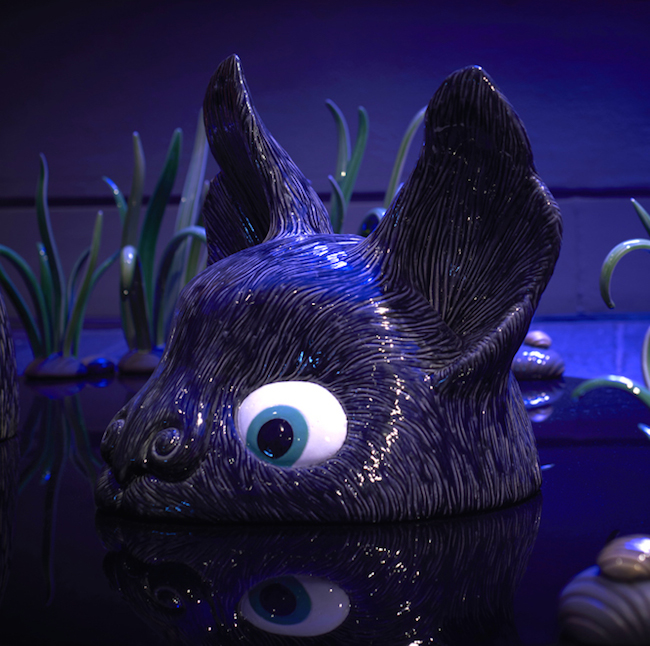If you’ve been following Malene Hartmann Rasmussen as we have, you’d know by now that she draws a lot of inspiration from fairy tales.
Malene Hartmann Rasmussen, In the Dead of Night (exhibition view), 2015, ceramics and mixed media installation. Photograph by Sylvain Deleu.
And we’re not necessarily talking about Disney-fied folklore, either (although the influence of Disney’s dark rides certainly marks this work). In In the Dead of Night (July 10 – August 30, Jerwood Makers Open 2015, Jerwood Space, London) Rasmussen hangs the twee iconography of Disney fairy stories along themes that are more closely aligned with Brothers Grimm. If you were walking through the woods and met an elf in a Disney story it may sing a catchy song with you. In Brothers Grimm? Not so much. If Rasmussen’s mixed media ceramic installations appear whimsical at first glance, you should look again. There are dark things lurking among the trees and — dear god— they appear to be hatching from acorns. Where are we and how do we escape?
This isn’t to suggest that Rasmussen is simply being tongue in cheek. She’s not creating fan art that depicts Disney princesses as punk rock singers, or sending us Krampus cards during Christmas. Rather, she gives us a new access point into classic folklore by hanging these two opposing narratives together. The softer aspects of In the Dead of Night meet modern audiences halfway, giving us a theme that we are more accustomed to in pop culture. The real meat of fairy stories — the hazy dream logic, the threat of the Other, the murky waters of collective narrative consciousness— are still present, allowing us to engage with them even though we tell ourselves we’re safely removed from the dark creatures who used to haunt the woods in preindustrial Germany. The truth of the matter is that these creatures never felt at home in the woods, they were always more comfortable inside our heads.

We’re inside a fantastical internal space rather than an external one. The mind is represented as a forest and all of our half-formed ideas, fears and anxieties grow dark fur and sharp teeth as they peek out at us from behind the trees. Rasmussen cites the 1970s Dario Argento film Suspiria as an influence. The works are similar because in both the danger seeps out of the location we occupy rather than from an externalized threat.
She was kind enough to give us an escape route. The rope ladder (with much of it trailing on the ground as though we weren’t sure how deep this hole went) is brightly lit and accessible in case we need to leave in a hurry.

A more intriguing possibility is offered to us, though. It takes the form of an ornate key hanging on the wall. It stands alone. Its importance is conveyed by a spotlight and by the fact that no other piece of art is hanging nearby. If this were a videogame, your immediate reaction would be to grab the key and look for a place to use it. Oh! That tree nearby has a suspicious-looking knot in its bark…
What does this key unlock? A way out? Is it a passage to somewhere even darker? Maybe we should decide what to do about these squat, smiling predators before we consider venturing a little deeper.
Bill Rodgers is a Contributing Editor for CFile.
Any thoughts about this post? Share yours in the comment box below.


Malene Hartmann Rasmussen, In the Dead of Night (exhibition view), 2015, ceramics and mixed media installation. Photographs by Sylvain Deleu.

Malene Hartmann Rasmussen





Add your valued opinion to this post.